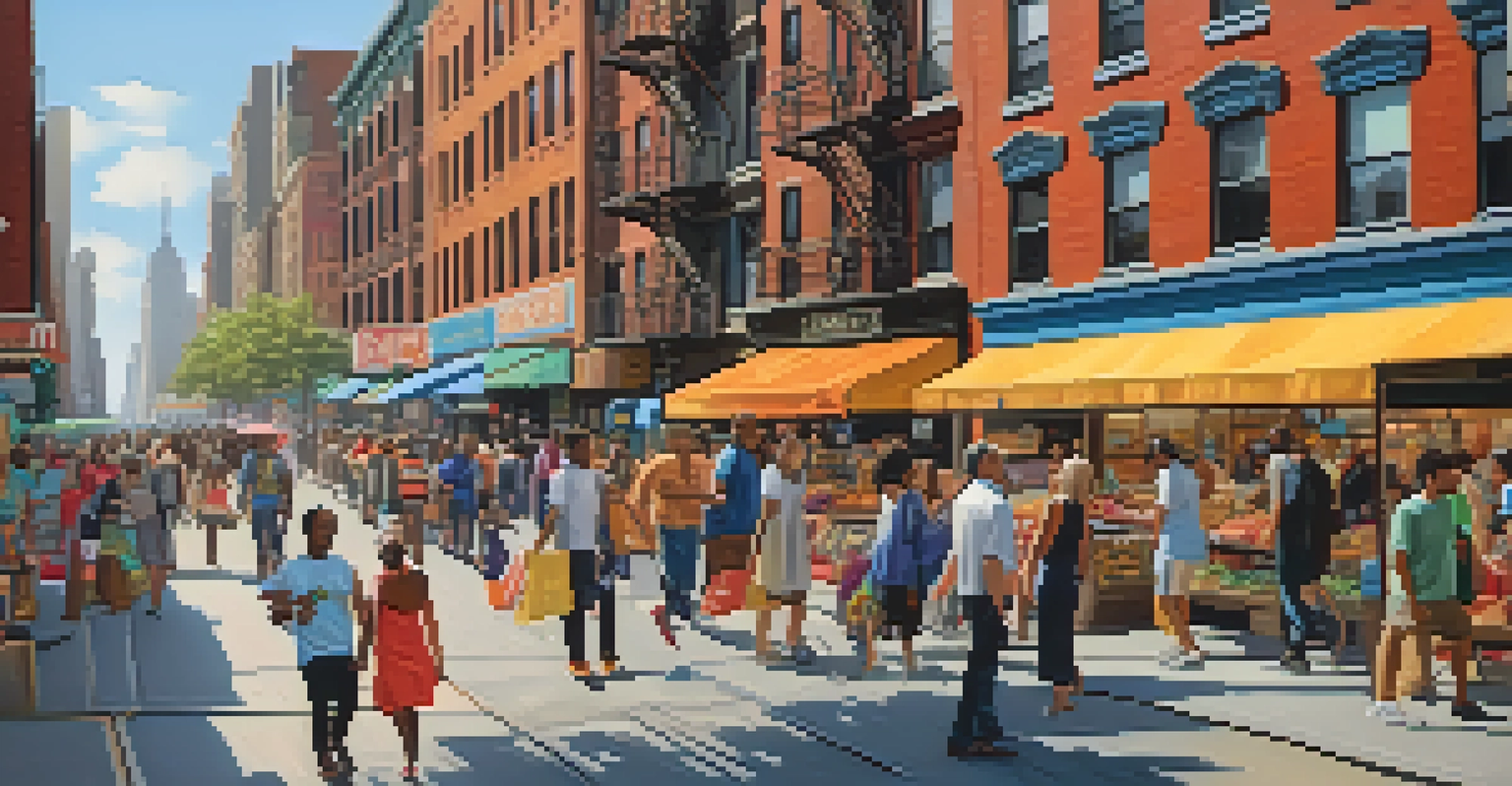Major Political Parties in New York: Influence and Ideologies

Overview of New York's Political Landscape
New York's political landscape is vibrant and diverse, reflecting its large population and rich history. With a mix of urban and rural areas, the state showcases a variety of political ideologies and party affiliations. This dynamic environment has led to intense competition and collaboration among major parties, shaping both state and national politics.
New York is a city that never sleeps, and its political landscape is equally dynamic, constantly evolving with the voices of its diverse population.
New York is primarily dominated by the Democratic Party, which has held a significant presence in state offices for decades. However, the Republican Party also plays an essential role, especially in upstate regions and suburban areas. Additionally, smaller parties, like the Green Party and the Independence Party, contribute to the political dialogue, offering alternative viewpoints.
Understanding this landscape is crucial for grasping how policies are formed and implemented in New York. The interplay between these parties influences everything from local governance to national elections, making it a fascinating case study in American politics.
The Democratic Party: Ideologies and Influence
The Democratic Party in New York is often characterized by its progressive ideologies, focusing on social justice, environmental issues, and healthcare reform. This influence is particularly visible in urban areas like New York City, where policies often reflect a commitment to inclusivity and equity. The party's leadership, including prominent figures like Governor Kathy Hochul, emphasizes these values in their agendas.

Historically, the Democratic Party has rallied around major movements, from civil rights to LGBTQ+ rights, which resonate strongly with the state’s diverse population. Their ability to mobilize grassroots support has made them a formidable force in elections, often resulting in high voter turnout. This grassroots activism showcases the party's connection to community needs and aspirations.
Democrats Dominate New York Politics
The Democratic Party's progressive ideologies and strong grassroots support significantly influence New York's political landscape.
In recent years, the Democratic Party has also faced challenges from more progressive factions, pushing the party to adapt and evolve. This tension between traditional Democrats and their progressive counterparts reflects a broader national trend, where the party grapples with defining its future direction while maintaining its core values.
The Republican Party: Ideologies and Influence
The Republican Party in New York, while often overshadowed by the Democrats, maintains a strong presence, especially in suburban and rural areas. Their platform typically emphasizes fiscal conservatism, law and order, and lower taxes, appealing to voters who prioritize these values. This influence is crucial in shaping policies that resonate with more conservative constituents.
Politics is not just about winning elections; it's about addressing the needs and aspirations of the people you serve.
Despite facing challenges in recent elections, the GOP has been actively working to broaden its appeal while staying true to its core beliefs. Influential figures, such as former New York City Mayor Rudy Giuliani, have played significant roles in shaping the party's image and strategies. Their focus on public safety and economic growth continues to attract support from various demographics.
The party's ability to adapt to New York's changing political landscape is evident in their outreach efforts. By engaging with diverse communities and addressing local concerns, Republicans aim to present themselves as viable alternatives, ensuring that their voices remain relevant in the state's political discourse.
The Role of Third Parties in New York Politics
Third parties, while not as dominant as the Democrats and Republicans, play a vital role in New York's political landscape. Parties like the Green Party and the Libertarian Party often introduce innovative ideas and policies that challenge the status quo. Their presence encourages broader discussions on issues such as environmental sustainability and individual liberties.
In recent elections, third parties have gained traction, particularly among younger voters seeking alternatives to the traditional two-party system. They often highlight topics that may not receive as much attention from the major parties, such as campaign finance reform and social justice initiatives. This can lead to a more vibrant political dialogue and encourage major parties to address these concerns.
Republicans Adapt to New Challenges
The Republican Party works to broaden its appeal in suburban and rural areas while addressing local concerns to remain relevant.
Although third parties usually face obstacles, including the difficulty of getting on the ballot and limited media coverage, they can influence election outcomes. By drawing votes away from major candidates, they compel both parties to consider a wider array of issues, ultimately enriching the political landscape in New York.
Impact of NYC on Statewide Politics
New York City, as the most populous city in the United States, significantly influences statewide politics. The city's liberal values often set the tone for the Democratic Party's agenda, affecting policies throughout the state. Issues such as affordable housing, public transportation, and education reform are frequently driven by NYC's unique challenges and needs.
The concentration of media and cultural power in New York City also plays a critical role in shaping public opinion and political discourse. Politicians and parties often find themselves responding to the narratives that emerge from the city, which can sway voter sentiment across the state. This dynamic underscores the importance of urban issues in the broader political conversation.
Moreover, the city's diverse demographics mean that various voices and perspectives can impact party strategies. Candidates often tailor their messages to resonate with NYC voters, which can lead to broader implications for statewide elections. As such, understanding NYC's role is essential for comprehending New York's overall political landscape.
Recent Trends in New York Politics
In recent years, New York politics has experienced notable shifts, particularly with the rise of progressive candidates. Figures like Alexandria Ocasio-Cortez have energized younger voters and pushed the Democratic Party to adopt bolder stances on issues like climate change and income inequality. This trend has led to an increased focus on progressive policies at both state and national levels.
On the Republican side, there has been a concerted effort to rebrand and connect with a broader audience. Strategies to appeal to suburban voters and minority communities have emerged, reflecting a recognition of the changing demographics in New York. This adaptability shows the party's commitment to remaining relevant in a rapidly evolving political environment.
Third Parties Spark Political Dialogue
Third parties like the Green Party introduce innovative ideas that encourage broader discussions and influence the major parties' agendas.
Additionally, recent elections have indicated a growing interest in voter engagement and turnout initiatives. Both major parties are increasingly aware that mobilizing their bases is crucial for success, leading to innovative approaches in campaign strategies. This focus on engagement highlights the importance of connecting with voters on a personal level, making politics more accessible and participatory.
Looking Ahead: The Future of New York Politics
As New York continues to evolve, its political landscape will likely undergo further transformations. The growing influence of progressive movements may push the Democratic Party to embrace more radical changes, shaping policies that address systemic issues. Conversely, the Republican Party's efforts to expand its base could lead to a resurgence in competitive elections, especially in key districts.
The role of technology and social media in politics cannot be overlooked, as these tools are increasingly used to engage voters and disseminate information. Candidates and parties that effectively harness these platforms will likely have an advantage in reaching younger constituents and mobilizing grassroots movements. This digital engagement is essential for fostering a more informed and active electorate.

Ultimately, the future of New York politics will depend on how well parties adapt to the changing needs and values of their constituents. By listening to diverse voices and addressing pressing issues, political parties can ensure their relevance and effectiveness in shaping the state’s future.